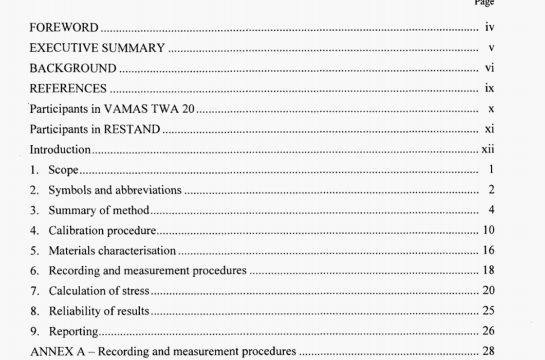ISO TTA 3 pdf download – Polycrystalline materials一Determination of residual stresses by neutron diffraction.
At pulsed sources, each pulse provides a diffraction profile across a cry large range of lattice spacings. As a fixed scattering angic is used, most instruments at spallation sources use radial focussing collimation that allows neutrons to be detected over a wider solid angle than would bc possible using a traditional slit, yet ensuring that all collected neutrons come from the defined sampling volume. The signal from the individual elements of the focussing collimator is combined by software taking into account the slightly different diffraction angle’.. Multiple radial collimators arc often used to enable more than one Q (strain) direction to be measured simultaneously. A typical dilTractometer used for strain measurement in twn perpendicular directions simultaneously at a pulsed spallation source is shown in Figure 4. A typical diffraction spectnirn from such an instrument is shown in Figure 5 which also shows the result of a Rietvcld profile refinement where a crystallographic model of the structure is fitted to the diffraction data using a least squares analysis.
3.5 Stress determination
Stress and eLastic strain arc second rank tensors which arc related through the elastic constants of a solid. Since neutron diffraction can be used to determine the elastic strain within a defined volume in a crystalline solid, it is possible to calculate the stress in that volume provided the relevant material elastic constants are known. Determination of the full strain tensor requires measurements of the elastic strain along at least six independent directions. If the principal strain directions within the body are known this can be reduced to three orthogonal directions. For plane stress or plane strain conditions, a further reduction to two directions is possible. For uni-axial loading measurement along one direction is sufficient.
The need to measure the strain in a given volume along a number of directions leads to the requirement that the specimen is accurately positioned with respect to the neutron beam collimation and the detectors. This is usually accomplished by mounting the specimen on motorised linear translation and rotation tables. By sequentially moving the specimen through this volume, which is fixed in space by the intersection of the incident beam and detector collimation, the spatial variation in elastic strain and, following measurement in other directions, stress can be mapped within a specimen or component.
4.5 Gauge ‘volumes
The nominal gauge volume (NGV) is defined as that volume of space that is occupied by the intersection of parallel beams of neutrons, which arc transmitted through the defining apertures for both the incident and diffracted ncutrons [Figure 6 a)). The centroid of the NOV is the geometric centre of this volume, and is usually coincident with the reference point (see 4.4),
The instrumental gauge volume (IGV) is the volume of space defined by the actual neutron beam paths through the defining apertures, taking into account beam divergence and the incident beam intensity profile [Figure 6 b)). The IGV can be defined by experiment or by simulation calculations, and will typically be expressed in terms of the neutron intensity distribution. Traditional methods of measurement of the instrumental gauge volume invoke scanning a small probe e.g. a thin (0,25 mm) wire2 through the instrumental gauge volume The dimensions can also be defined in terms of a FWIIM; whatever practice is adopted should be specified. The difference between the instrumental arid nominal gauge volumes may be particularly evident when only small volumes are being sampled. The centroid of the IGV is the centre of this volume, weighted for the beam intensity profile. lor most instruments it is coincident with the centroid of the NOV. Note that the IGV and NOV are only properties of the difiractometer itself.
ISO TTA 3 pdf download – Polycrystalline materials一Determination of residual stresses by neutron diffraction
